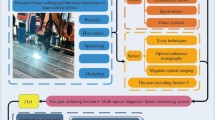Abstract
A laser vision sensing based on the adaptive tungsten inert gas (TIG) welding system for large-scale aluminum alloy components was established to fit various weld groove conditions. A new type of laser vision sensor was used to precisely measure the weld groove. The joint geometry data, such as the bevel angle, the gap, the area, and the mismatch, etc., aided in assembling large-scale aerospace components before welding. They were also applied for automatic seam tracking, such as automatic torch transverse alignment and torch height adjustment in welding. An adaptive welding process was realized by automatically adjusting the wire feeding speed and the welding current according to the groove conditions. The process results in a good weld formation and high welding quality, which meet the requirements of related standards.
Similar content being viewed by others
References
Li Keqin, Liu Zhihua, Zhou Liangang. State of art and trends of welding technology for the China’s space industry. In: Proceedings of International Forum on Welding Technology in Aviation and Space Industries, The Chinese Mechanical Engineering Society & Welding Institution of CMES. Beijing: China Machine Press, 2004, 68–74 (in Chinese)
Fan Pingzhang. Welding automation technology for aerospace carrier propulsion system. Aerospace Manufacturing Technology, 2000, (3): 42–48 (in Chinese)
Wu L, Chen S B. Intelligent Welding Technology. Beijing: China Machine Press, 2000, 207–211 (in Chinese)
Wang Q L. Real Time Sensing and Control of Process Quality for Arc Welding. Beijing: China Machine Press, 2000, 54–60 (in Chinese)
Boillot J P, Noruk J, Rimano L. Current applications & trends in intelligent control of joining processes in the automotive industry. In: Proceedings of International Forum on Welding Technology in the Automobile Industry, The Chinese Mechanical Engineering Society & Welding Institution of CMES. Beijing: China Machine Press, 2003, 88–100
Luo H, Chen X Q. Laser visual sensing for seam tracking in robotic arc welding of titanium alloys. International Journal of Advanced Manufacturing Technology, 2005, 26(9–10): 1012–1017
Orozco N J, Blomquist P A, Rudy R B, et al. Real-time control of laser-hybrid welding using weld quality attributes. In: Laser Institute of America, Proceedings of the 23rd International Congress on Applications of Lasers & Electro-Optics. San Francisco, USA: Laser Institute of America, 2004, 1–10
Author information
Authors and Affiliations
Corresponding author
Additional information
Translated from Journal of Beijing University of Technology, 2006, 32(8): 714–718 [译自: 北京工业大学学报]
Rights and permissions
About this article
Cite this article
Chen, Z., Song, Y., Zhang, J. et al. Laser vision sensing based on adaptive welding for aluminum alloy. Front. Mech. Eng. China 2, 218–223 (2007). https://doi.org/10.1007/s11465-007-0038-2
Issue Date:
DOI: https://doi.org/10.1007/s11465-007-0038-2




